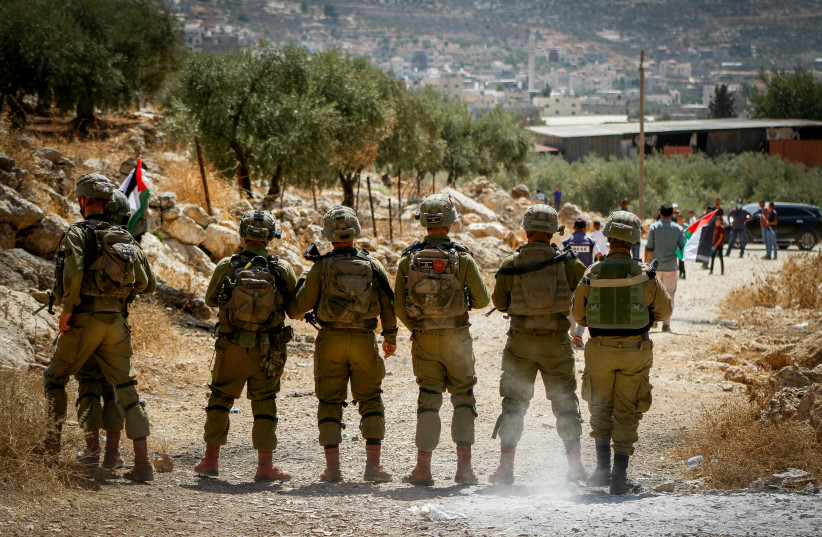The arms race in the West Bank is heating up. After a year of unprecedented and spiraling violence, a new phase of the crisis is emerging amid reports this week that the Palestinian Authority’s security forces may be receiving more than 1,000 rifles and some armored vehicles.
The PA received weapons from Jordan with Israel’s approval, Palestinian media outlets reported Tuesday. That could spark a political crisis here, but the government has categorically denied the reports.
The question is: How did we get here?
A year ago, it became clear that Palestinian Islamic Jihad (PIJ) and other armed groups were flush with weapons, as could be seen from videos and photos showing parades in Nablus and Jenin with gunmen carrying M-4 and M-16-style rifles, often with the latest sights and grips. Botched smuggling attempts uncovered new handguns that were being trafficked.
The United States Security Coordinator for Israel and the PA, which has supported the PA’s security forces for almost two decades, has called for increased PA control of cities that appear to be falling like sand through the grasp of the Ramallah-based authority.
Israel's West Bank operations against Palestinian illegal weapons
In July, Israel sent forces into Jenin to combat the rise. Although Israeli security forces operate daily in the West Bank, the two-day operation was unique in its magnitude. The IDF used drones and bulldozers, The Jerusalem Post reported at the time. Pro-Iranian media outlets, such as Beirut-based Al Mayadeen news channel, reported about an increased attempt by Iran to unite various Palestinian groups, such as Hamas and PIJ, and provide them with more weapons, including new improvised explosive devices.
Earlier this month, Prime Minister Benjamin Netanyahu said Israel would build a fence along the Jordan Valley border with Jordan – presumably to curtain the smuggling attempts, amid an increased focus and concern about Iran’s support for smuggling weapons.
Defense Minister Yoav Gallant acknowledged this emerging threat in late August when he said: “It is important to understand the significant change that is taking place on the ground. It is related to Iranian funding and to the proliferation of weapons under the Iranian directive. Iran seeks every means to harm the citizens of Israel.”
On Sunday, the IDF said: “As part of the ongoing activity to thwart the smuggling of weapons into Israeli territory, IDF and Israel Police forces identified a bag containing six explosive devices in the Jordan Valley area.”
As the PA attempts to slow the erosion of its power in the West Bank, Iran’s octopus-like threats remain pertinent all across the region. Tehran backs Hezbollah, which was recently revealed to be constructing an airstrip in Lebanon that could be used for drones.
Hamas has been increasing tensions along the Gaza Strip border as the anniversary of the Oslo Accords and the Disengagement from the Gaza Strip in 2005 have given it reasons to embellish its rhetoric. In the lead-up to the High Holy Days in Israel, it is natural that tensions will grow and be exploited by extremists.
This is why the arms race in the West Bank upped a notch in its importance. Voices on the political Right don’t want the PA to receive more weapons, citing the concern that they could be stolen or used against Israel.
Those who support the Oslo Accords want the PA to be strengthened and ask whether it will be able to train its personnel to use new M-4s and M-16-style rifles if it indeed receives them. Will they be willing to crack down on PIJ and other groups, or will they use the vehicles and weapons like swords around the throne to protect what remains of the PA’s strongholds in places like Ramallah and Hebron?
The PA already appears to be losing Jenin, Nablus, and Tulkarm, so focus on its activities remains a sensitive issue. It doesn’t want to be perceived as helping Israel, but it also cannot fall from power either.
At the same time, the Western backers of the PA don’t want to highlight security support. Even those that support the Palestinian police, such as the EU, are relatively quiet these days. Gone are the old days of US Gen. Keith Dayton and his more frequent discussions about the PA’s security goals.
In a situation like this, with Iran’s threats and Israel’s complex political environment, the storm over the weapons is about much more than a few dozen or 1,000 rifles.

